
views
Cleaning a Healing Wound

Follow the instructions your doctor has given you. The most important part of caring for a wound is following your doctor’s instructions. If you have not yet seen a doctor for a wound, then do so as soon as possible. Your doctor may advise you to: Keep your wound clean and apply any ointment they prescribe. Cover your wound when you bathe or shower to avoid getting it wet. Clean your wound with soap and water or with a special wound cleaner before applying ointment. Replace your bandages regularly and when they become dirty or wet.
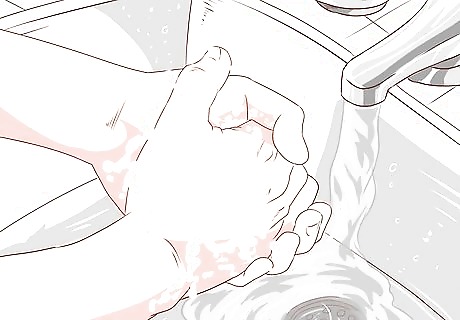
Wash your hands before and after cleaning the wound. Use an antimicrobial hand soap and warm water, and wash your hands for 15 to 30 seconds. Always wash your hands before and after cleaning the wound. Avoid touching the wound unless you’re cleaning it, and never scratch it if it’s itchy.

Soak the wound in a saline solution. If your doctor has advised you to soak your wound in a saline solution a certain number of times each day, then make sure that you do so. If not, then do not do this. Remove its dressing and soak an open or closed infected wound in a container of warm saline solution for 20 minutes. If it’s not easy to soak the wound in a bowl, cover the wound with a clean cloth soaked in saline solution for 20 minutes. You can create your own saline solution by mixing two teaspoons of salt with one quart (about a liter) of warm water.
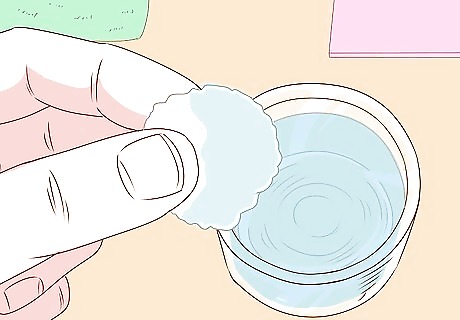
Use tap water to clean the wound. If you wouldn’t drink the water you’re using to clean the wound, you shouldn’t use it. You can use distilled or filtered water, and heat it with salt on the stove. Rinse your wound thoroughly and pat it dry. You can also just boil tap water and let it cool until it’s safe to use.

Apply an antibiotic ointment. Your doctor will usually prescribe something like bacitracin, silver sulfadiazine, gentamicin, or mupirocin. Dab an antibacterial cream onto a cotton swab, taking care not to let the tip of the nozzle touch the swab. Use enough cream to apply a thin coating over the entire wound. Use a fresh swab if you need to squirt more ointment from the bottle. Use an over-the-counter cream, such as Neosporin or petroleum jelly, if you haven’t been prescribed one from your doctor. You can also ask your pharmacist to recommend an over the counter antibiotic ointment. If your wound feels painful, you might even be able to find an ointment that has pain relief.
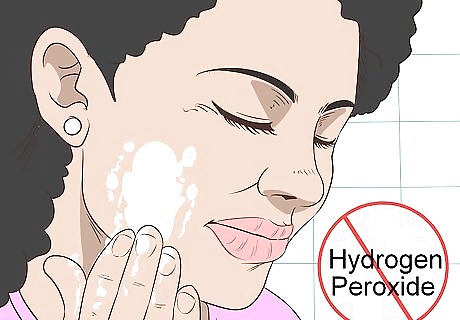
Avoid using alcohol or hydrogen peroxide. When it comes to treating wounds and skin infections, rubbing alcohol and hydrogen peroxide actually do more harm than good. Both interfere with the processes of healing and fighting infection. They dry your skin and kill white blood cells, which your body uses to kill the germs that cause infection.
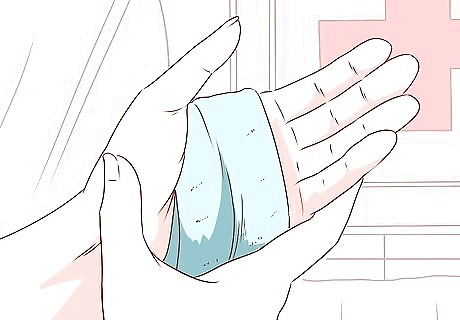
Replace the dressing to encourage healing. After cleaning the wound and applying ointment, use a clean cloth to dry the area around the wound so you can affix the dressing. Covering the wound will encourage healing and prevent the infection from spreading. You should change the dressing at least twice a day or when it gets wet or soiled. Avoid using a dressing that sticks to the wound. If you apply enough ointment, your dressing shouldn’t stick to your wound. Choose a sterile bandage instead of gauze.
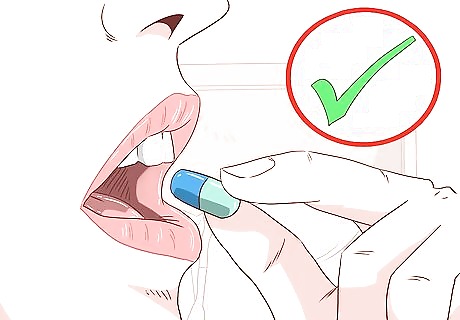
Follow all of your doctor's instructions. If your wound is infected, then you need to be under the care of a doctor. If you visited your doctor or another medical professional when you were injured or to treat an infection, be sure to follow all of their instructions. Apply prescribed topical antibiotic cream or take oral antibiotics as they've instructed. Take any other medications, such as pain relievers or anti-inflammatory drugs, as directed. If you received stitches, don't get them wet for 24 hours unless directed by your doctor.
Cleaning a Fresh Wound
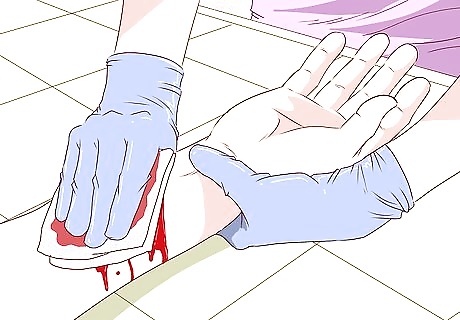
Stop the bleeding. Minor wounds, like surface scrapes or shallow cuts, usually stop bleeding on their own after a few minutes. If necessary, cover the area with a clean cloth or bandage and apply gentle pressure. Elevate the wound if possible, so the area is held higher than the heart. For example, if you have an arm or leg injury, elevate the limb to hold the wound at a higher point than your heart.
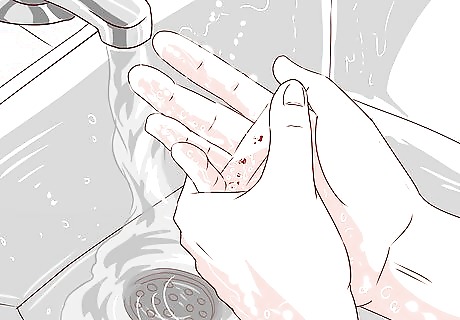
Flush a fresh wound for up to 10 minutes. Run warm water over a scrape or cut to remove debris and germs. Clean around the wound with a washcloth and mild soap or saline solution. Start cleaning the wound as soon as possible to prevent infection. Soak a puncture wound for 15 minutes in a warm saline solution to flush debris. If necessary, dip a pair of tweezers in alcohol to sanitize them, and use them to remove particles of debris from a scrape or cut that you can’t flush with water. Consult a doctor if you can’t remove any debris from a puncture wound or deep cut.

Apply antibiotic ointment or petroleum jelly and dress the wound. Use gauze to cover the wound with a thin coating of antibiotic ointment. Dress the wound with a sterile bandage. If necessary, use a clean cloth to dry the area around the wound so the bandage can adhere. Be sure to change the dressing at least once a day or whenever it comes damp or dirty. If the wound doesn’t become infected, just clean it with saline solution at least once daily or whenever you change the dressing.
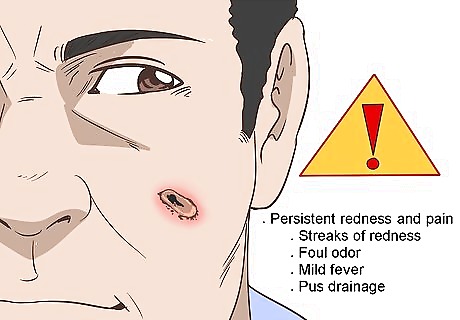
Check for signs of infection. As you care for your wound, make sure to check it often for signs of an infection and call your doctor if you notice any of these signs. These signs may include: Redness Swelling Heat (increased temperature at the wound site) Pain Tenderness Pus
Consulting Your Doctor

Have deeper wounds sutured. If the wound completely punctures through the skin or is wider than two millimeters, you should consult a doctor or visit an emergency clinic. If you have trouble closing the wound on your own or can see any exposed muscle or fat, you will likely need stitches. Getting stitches within a few hours of the injury will reduce the risk of scarring and infection. Keep in mind that wounds with jagged edges are more likely to become infected, so make sure you see a doctor if you have this type of wound.
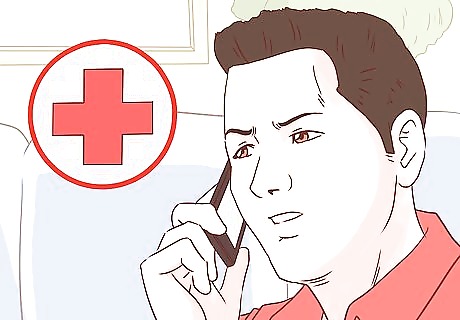
Make an appointment if the infection worsens. Call a doctor immediately if redness and swelling spread beyond the wound or infected site. If you’ve already seen your doctor, call them for a follow-up if a fever persists for two days after starting an antibiotic, or if the infected wound shows no signs of improvement for three days after starting an antibiotic. Signs of a worsening infection may include: Increased pain and swelling Red streaks traveling away from the wound A foul odor coming from the wound Increased amounts of pus and fluid coming from the wound Fever Chills Nausea and/or vomiting Swollen lymph nodes
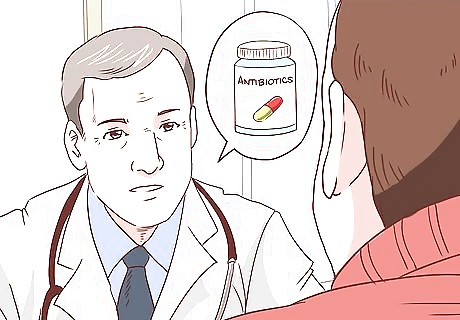
Discuss topical or oral antibiotics with your doctor. When you have your doctor examine the infected wound, discuss whether you should take topical or oral antibiotics. A topic antibiotic is an ointment that you apply directly on the infected area and is the most common form of treatment. Oral antibiotics, or systemic antibiotics, are taken by the mouth and are best if your doctor believes the infection is spreading or if your immune system is compromised. Tell your doctor about fever or any other symptoms, and be sure to mention any chronic health conditions or medications that might have weakened your immune system.

Ask your doctor about getting a tetanus shot. It’s always best to talk to a doctor about getting a tetanus shot if the wound is deep or dirty. Puncture wounds from soiled or rusty surfaces can cause tetanus, but most standard vaccination programs protect against the disease. If you haven’t had a tetanus shot in the last five years, you might need a booster.

Consult a doctor about chronic conditions and other concerns. You should contact your doctor immediately if you have any concerns about the nature of your injury or about your existing medical conditions. For example, be sure to consult a doctor if you take a prescription blood thinner or if your immune system is compromised. In addition to wounds from rusty or soiled objects, it's best to see a doctor for wounds from animal or human bites or with hard to remove debris. Also, keep in mind that some people are at an increased risk of infection, such people who are diabetic, elderly, obese, or immunocompromised (those who have HIV/AIDS, are undergoing chemotherapy, or who are on a steroid medication).

Seek immediate medical care for severe symptoms. In some situations, you may need to seek immediate medical care. Symptoms that indicate a need for immediate care include: Feeling short of breath Having a rapid heartbeat Feeling confused Having excessive bleeding that soaks through your bandages Feeling like your wound is ripping or noticing that it has actually come apart Having severe pain Noticing red streaks coming from the infected area



















Comments
0 comment